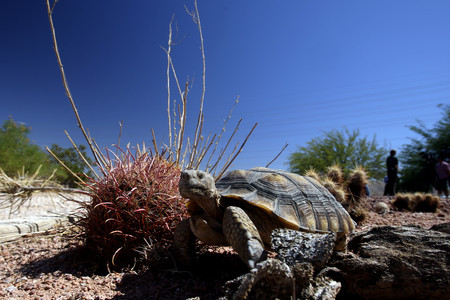TORTOISE REFORM SOUGHT
Some are unwanted. Some are displaced. Some are sick or hurt. Clark County picks up roughly 1,000 desert tortoises a year and takes them to a 220-acre conservation center where they are cared for, studied and sometimes released into the wild.
The center was opened two decades ago to aid wild tortoises displaced by development or maimed by cars. It is now being flooded with tortoises from people's backyards.
Although listed as threatened, tortoises can be kept as pets. County officials estimate that 98 percent of the tortoises they pick up are unwanted pets or the offspring of pets.
They want state and federal agencies to take over collecting and caring for the cast-off critters, arguing that the captive breeds are consuming too much of the funding intended to restore wild tortoise populations.
County commissioners will discuss the proposal Tuesday.
Both the U.S. Fish and Wildlife Service and the state Department of Wildlife oppose the move, saying it could violate the terms of the county's tortoise recovery program.
But Marci Henson, who oversees the program, contends that the county never envisioned having to shuttle and shelter so many jettisoned pets.
"It can't all fall on the back of the county," Henson said. "This is problematic and can't go on forever."
The county earmarks $250,000 yearly to handle unwanted tortoises, and the cost this year rose to about $700,000, she said. The money instead should go toward educating the public about caring for tortoises responsibly, she added.
By law, they can't be euthanized, and physically they can't be spayed or neutered, Henson said.
Scooping up the tortoises does nothing to deter people from carelessly breeding the animals, the root of the problem, she said.
Ten or 12 babies can hatch at a time, Henson said, recalling how a county worker once took 50 tortoises from one household.
A Fish and Wildlife Service official said the county is the best equipped to run a local pickup service and tend to the stray tortoises.
"We just have concerns about them stopping those two programs," said Rob Williams, the agency's state supervisor.
The county has hired a company to pick up tortoises seven days a week in response to a service line, he said.
The services are a small part of the county's tortoise recovery program, he said. Under a special permit, the county pays $2 million a year into the program.
In return, it collects $550 an acre from developers as part of grading fees on 145,000 acres exempt from the Endangered Species Act. The permit covers land developed in the valley because any terrain could have tortoise habitat, Henson said.
To date, the county has collected $34 million on 78,000 acres that have been developed, Henson said. It's now seeking to exempt another 215,000 acres from habitat protections.
Tortoises can be found on undeveloped desert land throughout the Southwest, Williams said. Their actual numbers are unknown because they are such reclusive creatures, he said.
The only lawful way to obtain a pet tortoise is through a certified adoption agency, but many people get them from friends or snatch them from the desert, both of which are illegal, Williams said.
Williams said it's crucial to prevent stray domestic tortoises from wandering unchecked into the wild because many have upper respiratory diseases that can spread to native populations.
The county opposed forming a task force to tackle those problems in tough budgetary times, Williams said, calling that understandable. The county should work with agencies in finding solutions, he said.
"I believe there is a solution with a calm mind and people sitting around the table," Williams said.
Henson said the county has a transition plan for gradually shifting more of the burden to state and federal agencies.
"We're not simply going to wash our hands of it and walk away," she said.
Wildlife agencies and the county allowed tortoises to be kept as pets after they were listed as threatened because residents already owned them, said Rob Mrowka, who runs the Center for Biological Diversity in Las Vegas.
The government should either phase out the provision allowing tortoises as pets or impose stricter controls Mrowka said.
Henson questioned why Fish and Wildlife was so concerned about tortoises' potentially spreading respiratory diseases in the region. A broad study showed that such ailments have never caused a die-off in the Mojave Desert, she said.
The agency has sounded no alarms in California, Arizona or Utah, she said. "Why are we being singled out?"
Still, San Diego Zoo researchers, who have run the conservation center since March, want to screen tortoises carefully for infectious diseases before releasing them.
About 3,000 tortoises are now in large pens at the site, and an estimated 9,000 have been set free since 1990, said Paula Kahn, who oversees the center for the zoo.
The zoo has strict criteria for returning captive tortoises to the desert, Kahn said, and the zoo has yet to release one.
Kahn foresees releasing former pets. Tortoises raised in captivity have shown they can adapt swiftly to a natural environment, she said.
"The real goal is to get the tortoises back out to the wilds," he said. "They really are a symbol of the desert, and they should be there."
Contact reporter Scott Wyland at swyland@reviewjournal.com or 702-455-4519.
WHERE TO CALL
Clark County residents who want to get rid of a pet tortoise they can't keep can call the tortoise pickup service at 702-593-9027.


















